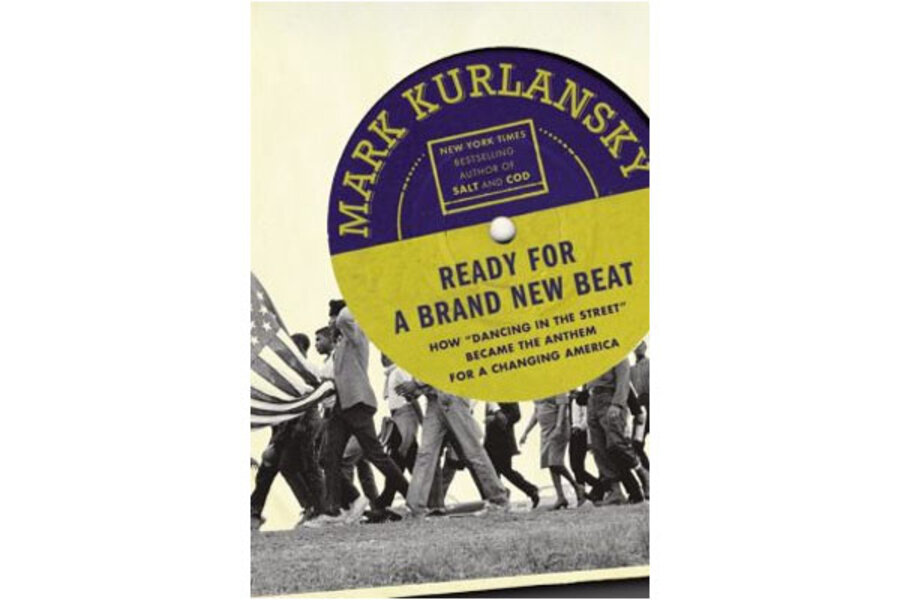Ready for a Brand New Beat
Loading...
In 1967, after a turbulent summer of violent uprisings in Detroit, Newark, and other cities across America, singer Martha Reeves went on tour in Britain. At a stop in London, a reporter confronted the Motown star about the urban riots, demanding to know whether her hit "Dancing in the Street" was a call to arms. Reeves, who always insisted that her signature song was nothing more than "a party song," burst into tears.
Mark Kurlansky, best known for micro-histories including "Salt" and "Cod," now turns his attention to Reeves's iconic song, written by Marvin Gaye, Mickey Stevenson, and Ivy Jo Hunter and recorded by Martha and the Vandellas in 1964. The book, Ready for a Brand New Beat, is crammed with intriguing material, even if its subtitle, "How 'Dancing in the Street' Became the Anthem for a Changing America," promises more than the author ultimately delivers.
One problem is that Kurlansky takes too long to get to "Dancing in the Street," padding the book with overly detailed background on everything from Elvis to Beatlemania to Detroit's influx of black families from the South.
Another is that by the time the author finally does arrive at the song's 1964 release and its continued popularity during the tumultuous years that followed, he has little more to bolster his case than recollections (albeit fascinating) by '60s radicals like Student Nonviolent Coordinating Committee (SNCC) chair H. Rap Brown, writer/activist Amiri Baraka, and Weatherman Mark Rudd, all of whom saw the song as having a hidden meaning promoting revolution and recalled its being played during riots and rallies. (Kurlansky's awkward way of spelling out that meaning is to ask a series of labored questions: "And did not 'calling out around the world' mean a call for revolution, and didn't the song include a list of cities, each with important black communities that were likely to have 'disorders'? What did it mean to be calling out to these cities for people to go dancing in the street now that summer's here and the time is right?")
Kurlansky alludes more than once to rumors that radio stations banned the song, fearing its potential to incite rioting, but he acknowledges that "no one has come up with a concrete example of a radio station outlawing it." By the time he reaches his final chapter, an assessment of the song's current cultural standing, he seems almost desperate to seal its historical status when he follows a paragraph about President Obama hailing "Dancing in the Street" as "the sound track of the civil rights era" with an even more thorough description of an obscure "American Idol" contestant performing it on the singing competition because she believed it to be "an anthem for the civil rights movement." Let's not even get into that chapter's strange profusion of quotations from Michael Bolton.
Despite these shortcomings, there is much in "Ready for a Brand New Beat" that makes the book worthy and engaging reading. The author provides a brisk summary of Motown's rich history, doing an excellent job of capturing the heady atmosphere at the two-story house in Detroit where so much classic R&B – music that helped racially integrate America's listening audience – was recorded.
One of the most remarkable elements of that history is what Mary Wilson of the Supremes dubbed "the Motown bubble," the way many Motown artists studiously ignored the political events roiling the country. (Reeves recently claimed that she had never even heard of SNCC, the organization at the heart of much of the civil rights movement.) Motown founder Berry Gordy, less interested in politics than in his bottom line, saw himself advancing the cause not by marching and demonstrating but by making black music mainstream.
Marvin Gaye was increasingly disgusted with the Motown bubble: "With the world exploding around me, how am I supposed to keep singing love songs?" he later wrote in his autobiography. When he first brought his classic protest song "What's Going On" to Gordy, the Motown boss called it "the worst thing I ever heard in my life" and discouraged Gaye from releasing it. "If you're gonna do something different, at least make it commercial," he sniped.
Co-writers Stevenson and Hunter insist to this day that "Dancing in the Street" had no hidden agenda. Kurlansky, of course, could not interview the song's third writer, Gaye, who was killed by his father in 1984, but the author speculates that the late singer would have been politicized enough by 1964 to have intended a deeper meaning to "Dancing in the Street."
Reeves was eventually – and callously – dumped by Motown when Gordy fled the Motor City in 1972 and moved the company to Los Angeles. She still lives in Detroit – that is, when she's not out on tour performing her most enduring hit.
"I never get tired of singing 'Dancing in the Street,' " she told Kurlansky. "Every time you sing it, it is different. Different musicians, different crowd, a different happy. It makes me happy to sing it." Amiri Baraka, who goes so far as to tell Kurlansky that he believes "Dancing in the Street," with its future tense ("There'll be dancing..."), "prophesied the rebellion," cherishes his understanding of the song as much as Reeves does hers. Told by Kurlansky that all the living principals involved with its creation denied his interpretation, Baraka replied, "It doesn't matter to me what they meant."








